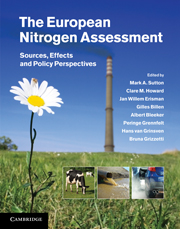Book contents
- Frontmatter
- Contents
- List of contributors
- Foreword
- Summary for policy makers
- Technical summary
- 1 Assessing our nitrogen inheritance
- Part I Nitrogen in Europe: the present position
- Part II Nitrogen processing in the biosphere
- Part III Nitrogen flows and fate at multiple spatial scales
- 10 Nitrogen flows in farming systems across Europe
- 11 Nitrogen flows and fate in rural landscapes
- 12 Nitrogen flows and fate in urban landscapes
- 13 Nitrogen flows from European regional watersheds to coastal marine waters
- 14 Atmospheric transport and deposition of reactive nitrogen in Europe
- 15 Geographical variation in terrestrial nitrogen budgets across Europe
- 16 Integrating nitrogen fluxes at the European scale
- Part IV Managing nitrogen in relation to key societal threats
- Part V European nitrogen policies and future challenges
- Glossary
- Index
- References
16 - Integrating nitrogen fluxes at the European scale
from Part III - Nitrogen flows and fate at multiple spatial scales
Published online by Cambridge University Press: 16 May 2011
- Frontmatter
- Contents
- List of contributors
- Foreword
- Summary for policy makers
- Technical summary
- 1 Assessing our nitrogen inheritance
- Part I Nitrogen in Europe: the present position
- Part II Nitrogen processing in the biosphere
- Part III Nitrogen flows and fate at multiple spatial scales
- 10 Nitrogen flows in farming systems across Europe
- 11 Nitrogen flows and fate in rural landscapes
- 12 Nitrogen flows and fate in urban landscapes
- 13 Nitrogen flows from European regional watersheds to coastal marine waters
- 14 Atmospheric transport and deposition of reactive nitrogen in Europe
- 15 Geographical variation in terrestrial nitrogen budgets across Europe
- 16 Integrating nitrogen fluxes at the European scale
- Part IV Managing nitrogen in relation to key societal threats
- Part V European nitrogen policies and future challenges
- Glossary
- Index
- References
Summary
Executive summary
Nature of the problem
Environmental problems related to nitrogen concern all economic sectors and impact all media: atmosphere, pedosphere, hydrosphere and anthroposphere.
Therefore, the integration of fluxes allows an overall coverage of problems related to reactive nitrogen (Nr) in the environment, which is not accessible from sectoral approaches or by focusing on specific media.
Approaches
This chapter presents a set of high resolution maps showing key elements of the N flux budget across Europe, including N2 and Nr fluxes.
Comparative nitrogen budgets are also presented for a range of European countries, highlighting the most efficient strategies for mitigating Nr problems at a national scale. A new European Nitrogen Budget (EU-27) is presented on the basis of state-of-the-art Europe-wide models and databases focusing on different segments of Europe's society.
Key findings
From c. 18 Tg Nr yr−1 input to agriculture in the EU-27, only about 7 Tg Nr yr−1 find their way to the consumer or are further processed by industry.
Some 3.7 Tg Nr yr−1 is released by the burning of fossil fuels in the EU-27, whereby the contribution of the industry and energy sectors is equal to that of the transport sector. More than 8 Tg Nr yr−1 are disposed of to the hydrosphere, while the EU-27 is a net exporter of reactive nitrogen through atmospheric transport of c. 2.3 Tg Nr yr−1.
The largest single sink for Nr appears to be denitrification to N2 in European coastal shelf regions (potentially as large as the input of mineral fertilizer, about 11 Tg N yr–1 for the EU-27); however, this sink is also the most uncertain, because of the uncertainty of Nr import from the open ocean.
- Type
- Chapter
- Information
- The European Nitrogen AssessmentSources, Effects and Policy Perspectives, pp. 345 - 376Publisher: Cambridge University PressPrint publication year: 2011
References
- 54
- Cited by



